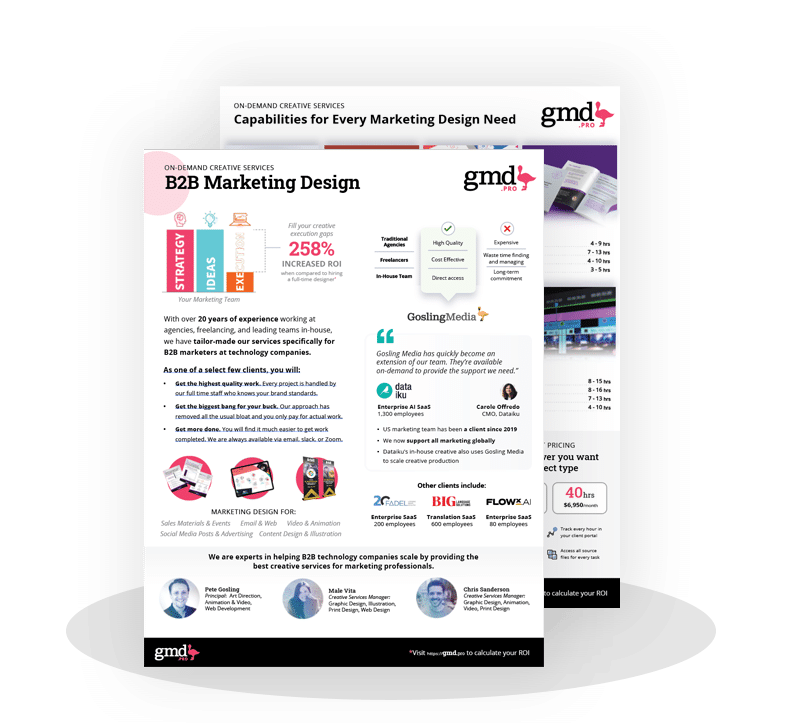B2B design projects often face delays, costing businesses time, money, and opportunities. Here’s how to tackle the top challenges:
- Poor Communication: Causes misaligned expectations and rework.
Solution: Use tools like Slack or Microsoft Teams for clear, real-time updates. - Inadequate Planning: Leads to missed deadlines and resource conflicts.
Solution: Define project scope, set deadlines, and hold regular check-ins. - Scope Creep: Increases costs and extends timelines.
Solution: Use change request rules and written approvals to manage changes. - Limited Resources: Creates bottlenecks and reduces quality.
Solution: Plan workloads, track time with tools like Clockify, and consider freelancers. - Complex Approvals: Stalls progress with lengthy review cycles.
Solution: Schedule fixed feedback deadlines and use design previews for faster approvals.
Quick Comparison of Tools
| Tool | Best For | Key Features | Starting Price |
|---|---|---|---|
| Asana | Large teams | Custom workflows, updates | $10.99/user/month |
| ClickUp | Visual planning | Task views, mind maps | $7/user/month |
| Trello | Small teams | Kanban boards, automation | $5/user/month |
| Wrike | Complex projects | Gantt charts, spreadsheets | $10/user/month |
By addressing these delays with clear processes, the right tools, and better communication, you can keep projects on track and within budget.
How to Manage Difficult Stakeholders: 6 Common Challenges
1. Setting Clear Project Expectations
When project expectations are unclear, delays, increased costs, and disrupted schedules often follow. Establishing clear, detailed requirements from the beginning helps avoid these issues and keeps everything on track. Here’s how you can set the right expectations.
Define Project Scope and Requirements
A well-defined project scope is essential to avoid confusion and prevent unnecessary changes. A clear scope document should outline deliverables, timelines, and resource allocation in detail.
Here’s how successful B2B design teams typically structure project requirements:
| Component | Description | Example |
|---|---|---|
| Objectives | Measurable goals | Increase landing page conversion by 25% |
| Resources | Team and budget | 3 designers at 30 hours/week, $7,000 budget |
| Deliverables | Outputs with dates | 5 landing page designs by June 15, 2025 |
| Exclusions | Not included | Custom animations, video production |
A well-structured scope document provides a solid foundation for tracking progress and conducting regular reviews.
Schedule Progress Check-ins
Regular progress check-ins help identify potential roadblocks early and keep everyone aligned. Weekly leadership meetings are an effective way to ensure the project stays on course. Consider these tips:
- Set fixed deadlines for feedback to avoid delays.
- Schedule reviews at key milestones to assess progress.
- Ensure decision-makers are available for critical meetings.
"One day’s delay is another day’s lack of progress." – Stuart Bowen
Use Design Previews
Design previews streamline the review process and speed up approvals. Tools like Figma make it easy to gather real-time feedback. Here are three strategies to make the most of design previews:
- Early Wireframes: Share low-fidelity designs early on to confirm layouts and functionality before diving into detailed work.
- Interactive Prototypes: Use clickable prototypes to showcase user flows and interactions, helping stakeholders visualize the final product.
- Collaborative Review Sessions: Host live review sessions where stakeholders can give immediate feedback and see updates in real-time, reducing miscommunication.
These steps ensure everyone stays on the same page, minimizing revisions and keeping the project moving forward.
2. Fix Slow Project Workflows
B2B design projects often face delays due to inefficient workflows. In fact, studies show that 22% of bottlenecks happen specifically during project management tasks.
Pick the Right Project Tools
Choosing the right tools can make a huge difference in how smoothly your projects run. Data shows that using effective tools can boost team productivity by 300-400%. Here’s a quick comparison of tools that work well for B2B design projects:
| Tool | Best For | Key Features | Starting Price |
|---|---|---|---|
| Asana | Large teams | Customizable workflows, real-time updates | $10.99/user/month |
| ClickUp | Visual planning | 14 task views, mind maps | $7/user/month |
| Trello | Small teams | Kanban boards, automation | $5/user/month |
| Wrike | Complex projects | Spreadsheet interface, Gantt charts | $10/user/month |
Once you’ve selected the right tools, focus on standardizing your processes to cut down on inefficiencies.
Create Standard Processes
Process inefficiencies are responsible for 58.33% of bottlenecks. Adam Stoker from Relic highlights this issue:
"The biggest bottleneck in our business has been the difficulty in making sure that context is transferred in its entirety when information changes hands between multiple people and departments".
Here are some ways to streamline your processes:
- Develop detailed documentation for routine design tasks.
- Use standardized templates for project briefs and feedback.
- Define clear handoff protocols for team transitions.
- Set up automated quality control checks to catch errors early.
Use Sprint-Based Planning
Sprint planning is a great way to manage large projects. Teams using this method report up to a 250% improvement in work quality. Breaking projects into smaller, focused tasks helps maintain steady progress.
Key steps for sprint planning include:
- Two-Week Sprints: Define clear goals and deliverables for each sprint.
- Daily Stand-ups: Short 15-minute meetings to identify blockers and track progress.
- Sprint Reviews: Evaluate outcomes and collect feedback at the end of each sprint.
"It’s not just about speed. It’s also about momentum, focus, and confidence." – John Zeratsky, best-selling author
To catch workflow issues early, 55.56% of experts analyze qualitative factors like stress levels and work backlogs, while 44.44% rely on metrics from dashboards. Regularly monitoring these indicators can help you keep projects on track and avoid delays.
Next, we’ll dive into how communication gaps can further stall progress and how to address them effectively.
sbb-itb-3ff8c64
3. Fix Communication Gaps
In B2B design projects, poor communication often leads to delays, mistakes, and missed deadlines. In fact, communication barriers cost companies around $62.4 million annually.
Set Up Team Communication Tools
The right tools can make collaboration smoother and more effective. For example, companies using Slack have reported a 47% boost in productivity. Here’s a quick breakdown of some popular platforms:
| Platform | Best For | Key Features | Monthly Cost |
|---|---|---|---|
| Slack | Cross-team collaboration | 2,600+ app integrations, AI tools | From $7.25/user |
| Microsoft Teams | Large organizations | PowerPoint Live, AI meeting notes | From $4/user |
| Miro | Visual collaboration | Digital whiteboards, templates | From $8/user |
"Without a doubt, the fluid collaboration that Teams enables has a positive impact on our ability to be responsive and focus on the work to be done".
Once you’ve got the tools in place, tracking daily progress is the next step to staying aligned.
Track Daily Progress
Nearly 48% of projects fail to meet their original deadlines. To avoid this, keep everyone on the same page by:
- Hosting 15-minute daily standups to discuss completed tasks, upcoming work, and any blockers
- Sharing short written updates using your communication platform
- Documenting milestone achievements and sharing them with stakeholders
These habits help maintain focus and prepare teams for efficient design reviews.
Use Design Review Tools
Tools like Figma and InVision have become go-to solutions for collaborative design reviews. They help streamline feedback and speed up project timelines. To make the most of these tools, try the following:
- Set up dedicated feedback channels to keep discussions organized and actionable
- Use clear annotation systems, such as color-coding or standardized formats, to prioritize feedback
- Establish firm deadlines for feedback to ensure the project stays on track
4. Handle Limited Resources
Limited resources can significantly affect B2B design project timelines. Since March 2020, 6.3 million people have quit their jobs due to burnout caused by being under-resourced. Managing resources effectively starts with smart workload planning.
Plan Team Workloads
Careful workload planning helps prevent burnout while keeping productivity high. Here are some ways B2B design teams can manage their workloads:
- Train team members to handle multiple roles
- Focus on tasks that deliver the most impact
- Use tools like Gantt charts or Kanban boards to track progress
Work with Outside Teams
Collaborating with external teams is becoming more common, with 37% of teams planning to depend more on freelancers in the next three years. Gosling Design Studio offers a solution with its Studio Hours plan. For $1,975 per month, you get 10–40 hours of dedicated creative services, and any unused hours roll over.
"When you collaborate with other people, everybody needs to be on the same page in order to make effective progress. Everybody has to know their role." – Michael Ellis, Copy Consultant at Soaring Eagle B2B Consulting Services
To ensure smooth collaboration with external partners:
- Share your brand guidelines and project details early on
- Set up clear communication channels
- Define deliverables and deadlines
- Schedule regular check-ins to stay aligned
Monitor Team Time Use
Time tracking tools are essential for improving how resources are used and identifying problem areas. Clockify, trusted by over 5 million users worldwide with a 95% satisfaction rate, offers detailed tracking capabilities.
"Clockify has been an essential tool for our team to track time on a daily basis." – Camille Ang, Entrepreneur
Some effective strategies include:
- Compare billable hours to budgets
- Keep an eye on team capacity
- Study productivity trends
- Adjust workloads based on real-time insights
5. Stop Project Scope Creep
Scope creep can derail B2B design projects, with 43% of completed projects going over budget and 48% missing deadlines, according to PMI’s Pulse of the Profession survey. Uncontrolled changes in a project can push timelines, hurt team performance, and leave clients dissatisfied.
Set Up Change Request Rules
A clear change request process helps keep projects on track while allowing for necessary adjustments. Research from ProjectManager highlights how uncontrolled changes often lead to scope creep.
| Change Request Component | Required Information | Purpose |
|---|---|---|
| Impact Assessment | Timeline, budget, resources | Determine if changes are viable |
| Approval Workflow | Stakeholder roles, authority | Clarify decision-making process |
| Documentation | Change details, justification | Ensure accountability |
"Change is an intrinsic part of project management, whether it comes from the client or internally. Depending on how that change is handled, it can result in scope creep." – Yulia Miashkova, Content Creator
By structuring change requests, you can establish and maintain firm project boundaries.
Define Project Limits
Once you have a controlled change process, it’s crucial to set clear project limits. Use a detailed scope baseline and a work breakdown structure (WBS) to outline what the project includes – and what it doesn’t.
- List all requirements and deliverables
- Set key timeline milestones
- Define budget and resource constraints
Get Written Approvals
Written documentation ensures accountability and provides a reliable reference for any changes. Here’s how to handle approvals:
-
Create Approval Documentation
Use standardized forms to capture requested changes, their impact on the timeline and budget, and the signatures of necessary stakeholders. -
Establish Approval Authority
Clearly define who can approve changes, factoring in their impact on costs, deadlines, and resources. -
Document Verbal Agreements
Always follow up verbal agreements with written records. Include detailed descriptions of the change, updated costs, and revised timelines.
This structured approach helps ensure that project changes are managed effectively, keeping scope creep in check.
Preventing B2B Design Delays
Nearly half of projects – 48% – miss their deadlines, and 43% go over budget. Managing B2B design effectively can help avoid these common pitfalls and ensure projects stay on track.
The key to success lies in defining the project scope clearly, allocating resources wisely, and identifying risks early. Strong communication paired with organized processes keeps everyone aligned. Tools like collaboration platforms and regular feedback loops help teams and stakeholders stay on the same page. Automated workflows and formal change management processes reduce disruptions and keep things moving smoothly.
Technology also plays a big role in keeping projects on schedule. Teams using project management software often experience fewer delays than those relying on basic tools. These platforms enable real-time communication, simplify workflows, and provide clear visibility into project progress.
To avoid scope creep, documented change controls are essential. Regular reviews and standardized processes help identify potential bottlenecks and maintain consistency.
Staying on schedule isn’t just about hitting deadlines – it’s about delivering high-quality work that satisfies clients while keeping the team productive. By focusing on these strategies and maintaining strong oversight, teams can achieve better outcomes.







